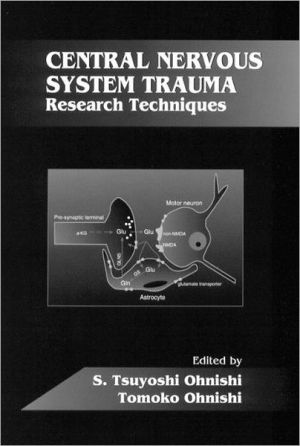

 |

|

The average rating for Central Nervous System Trauma: Research Techniques, Vol. 4 based on 2 reviews is 2.5 stars.
Review # 1 was written on 2015-09-14 00:00:00 Jason Austin Jason AustinA. Synopsis: Technological advances in medicine (microscope, thermometer, stethoscope, X-rays, electrocardiograph, and the computer) during the last 4 centuries have; 1. Changed methods of diagnosis. "Subjective evidence" (patients sensations and physicians observations) is being replaced by the "objective evidence" based on these new tools 2. Influenced the systems of providing medical care and treatment. The emphasis on technology has led to the rise of the specialist (and the centering of medical care in the hospital) and the decline of the general practitioner. 3. Altered the relationship between physician and patient. The reduction of personal contact has increased doctor-patient alienation. This book points out the dangers and benefits inherent in the relationship between man and machine B. [Patient data] In the 17th century patient diagnosis was primarily verbal (listened to the patient describing the symptoms) and visual (observed the appearance of the body and its fluids. In the 18th century the physician began to use manual techniques (percussion, dissection). C. [Sound data] The stethoscope and the detection of disease by sound replaced some of the older methods of diagnosis (subjective impressions from the patient). D. [Visual data] In the 2nd half of the 19th century new technologies allowed the physician to view the inside of the body (X-ray). This replaced some of the sound techniques as visual data was believed to be more objective. E. [Enhanced visual data] The microscope was the key diagnostic instrument at the turn of the century. These observations could take place without the patient in the room. Beginnings of doctor-patient alienation. F. [Chart data] Respiration, circulation, and other physiological functions were turned into chart data. The patient could be studied over time by more than one doctor. G. [Chemical data] At the turn of the 20th century the diagnostic laboratory, with the emphasis on chemical data, became widespread. This increased the numbers of specialists (centralized in hospitals) and saw the decrease in the general practitioners. H. [Computer data] More than any other diagnostic instrument the computer has raised anxieties among physicians that they might one day be replaced by machines. The computer further helped to centralize medicine at the hospital where large data banks could be stored. I. What are the shortcomings of technology in diagnosis? The doctor's knowledge of disease is increased but technology erodes his confidence to make independent judgments. The doctor is then just an intermediary between patient and machine. |
Review # 2 was written on 2018-07-30 00:00:00 James Culverhouse James CulverhouseThis is now one of my new favorite one volume histories of medicine. Even though it concentrates on the development of technology in medicine, and the author's underlying concern from the beginning is that physicians have sacrificed much of their personal relationship with the patient by adopting technology, it is a great and detailed discussion of auscultation, microscopy, the ophthalmoscope, the EKG, the roentgenogram, clinical chemistry and more. All histories must mention RTH Laennec, relate a tired discovery story, leave the reader to assume that the technology was adopted immediately and without complaint and then move on to the next item on the list, but Professor Reiser discusses the environment that the technology developed in, what the known probable sources were, who disliked or refused to use the new technology and why, and how and when it came to be used in common practice. All fascinating stuff; real history. This book was published in 1978 so its discussion of computers is dated in some ways, but in its essence nothing is really lost. As a personal complaint only, I think the book would be strengthened by more mention of the deleterious effects of the philosophy of mass automated screening of normal people - the false positives, the uncertain value to the patient of finding a true positive that might have had no effect on their life, whether a test is useful when it's clear that nothing can be done with the result, and what is sacrificed to pay for it all. |
CAN'T FIND WHAT YOU'RE LOOKING FOR? CLICK HERE!!!